
















Backstage
2023 Backstage: Coming Soon!
2022 Backstage:
RGB Snowflakes
This year we added ten RGB (red/green/blue) snowflakes to our mega-tree. We can mix brightness of the RGB channels to produce any of millions of colors, though we typically only use different brightnesses of a select set of hues used elsewhere in the display (red, orange, yellow, green, cyan, blue, magenta, cold white, and warm white). The snowflakes are custom made just for our tree. Each snowflake contains 42 RGB LEDs on a snowflake shaped circuit board. The board is enclosed in a 3D printed shell made in 3 parts from semi-translucent and black PETG plastic.
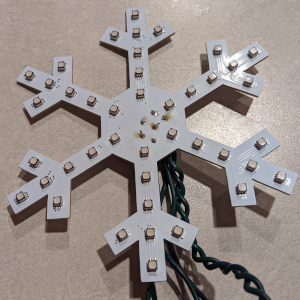
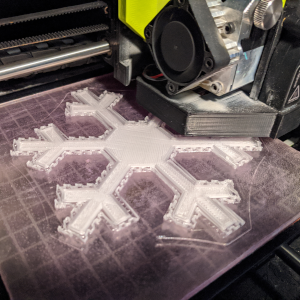
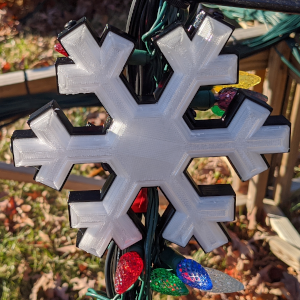
New Strobes
This year we upgraded our strobe lights on the mega-tree. This is actually third generation of strobe lights we have used on the tree. The first ones over a decade ago were commercially available "curtain strobes" based on a Xenon flash tube. Due to defects those strobes we unreliable and did not last very long. The second generation was improvised from a 20 LED MR-16 bulb and simple 555 timer circuit housed in plumbing parts. Although those were still working, this year we decided to finally do it right. Like the snowflakes, our 2022 strobes are custom made. Each contains 17 LED packages containing 3x white LEDs in each package. Instead of going with a simple timer circuit, these use a microcontroller to control the pulses of light. Using a microcontroller allowed us to add some randomness to the delay between flashes, which improves the overall effect (the illusion of the sparkling flash pattern is no longer broken by repeating patterns). As with the snowflakes, these are enclosed in a custom semi-transparent and black 3D printed PETG enclosure that is less than 3/4" thick (we call them our strobe "pucks").
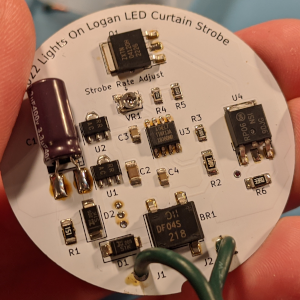

New LEDs and Controller Modification [!Highly Technical Section!]
This year brought a complete replacement of our LED light strings on the mega-tree. The previous strings, from 2008, had been experiencing a failure rate of around 20% the past couple years and we were running out of spares. It was time for an expensive but necessary replacement. The 2008 strings also contained a strange design which resulted in some odd behaviors. [Technical Alert!] What follows is for the electronics nerds / those with their own displays and can be skipped if that is more than you are here for. Here we go... the 2008 LED strings were an unusual "voltage multiplier" design, where the incoming 120VAC was voltage multiplied into more than 300 volts DC through a network of capacitors and diodes. This design is very rare and unusual in christmas lights (most are simple full/half wave strings of LEDs). Advantages to this technique included an inherently flicker free operation (even better than full wave) and not needing the extra rectifier "blob" at the middle of a 70 count string. A huge disadvantage was all of the capacitance. Our triac based dimmers absolutely hated those strings! Debugging strings that would become stuck on and ridiculously unusual lookup tables for the lighting curves were completely normal for these. In many applications we had to keep an incandescent string in parallel with the LEDs just to make them work at all (hidden away in an opaque box out of sight -- which partially defeats the point of using LEDs).
Our 2022 strings are a completely ordinary full wave design that eliminates those problems, but they introduced an entirely new problem. To our complete surprise when testing in early November, the new LEDs looked awful on our controllers! Ramps were completely unstable. At first the obvious assumption was that it was the triac nature of the controllers under low load, but adding additional load did nothing to fix the issue. The problem was isolated to just our 2006-2009 era D-Light controllers that had been converted to open DMX firmware. Once I attached an oscilloscope the problem became obvious. It was not the triacs at fault at all, but rather it was a firmware bug causing completely missed pulses to the opto/triac pair.
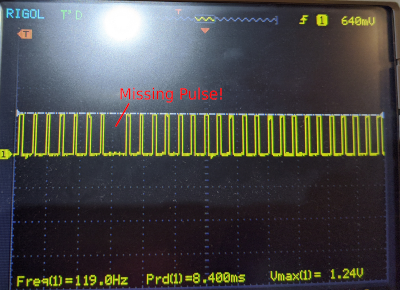
To be sure I checked that the zero cross circuitry into the PIC microcontroller was good. It was. Yet, at times the correct pulse never left the microcontroller, which resulted in a 1/120s flicker of the LEDs. It only happened during ramps, so I assume the firmware just gets too busy and overruns a zero cross. On our previously overly-capacitive strings this was never (or barely) noticible, but on the new faster strings it was super obvious. These controllers are pretty much obsolete at this point. They are no longer made and the firmware has not been maintained in about a decade. I happen to have the source code, but I've never written for PIC microcontrollers before, so learning the architecture and finding the bug in someone else's code in less than a couple weeks was next to impossible. What I needed to save the day was a creative hack...
Drumroll for the creative hack...
The firmware bug only affected the D-Light ACx16 controllers. We also have a similar vintage Lynx Express controller which worked perfectly. Both are based on very similar designs at the triac end of things. What if I could take the microcontroller that works from the Lynx, adapt it, and use it to drive the triacs on the D-Light board? What followed was a frenzied reverse engineering of both circuits and a very rapid prototype with a breadboard and a bunch of jumper wires to the ACx16 sockets. The ACx16 used 5v, but the Lynx used a 3.3v micro, so a LDO regulator was required. The ACx16 used a port multiplier design that drove the optoisolators on the high side. The Lynx drove the optos directly from the low side. The port multiplier was discarded and the Lynx outputs go through a level shifting inverter to high side drive the D-Light optos. The zero cross detection circuits were very different, but I was able to adopt a hybrid design that gave the Lynx micro what it needed from the ACx16 board. It worked! All that was needed was a board that fit everything in the required space (the board needed to snap into the two IC sockets on the ACx16). It also had to use parts that were in stock. Two and a half weeks after it all began, our boards were finished and installed. After a single 0.1uF capacitor bodge to fine tune the zero cross circuit (it was 500 microseconds too early in the original iteration), it worked perfectly. As a bonus, the Lynx firmware has a 10-bit lookup table where the ACx16 only had 8-bit lookup. Not only was it a hack, but it was also an upgrade! I've never seen an ACx16 look so good with LEDs. I present the world's first D-Light ACx16 with a Lynx Express brain transplant:
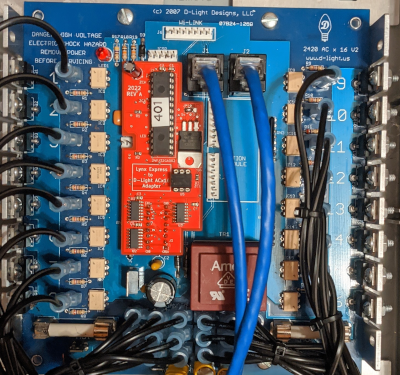
With more time available I have no doubt that I could have come up with a more elegant solution, but this is the hack which saved Lights On Logan in 2022!
More Channels
With the addition of RGB snowflakes and some other regrouping of things for this year, it was necessary to add more channels to the show. We now have increased from 388 to 416 channels.
Previous 2020/2021 Backstage:
The Lights:
Our 2020 display has 35,295 lights in six colors (Red, Yellow, Green, Blue, Violet, and White).
Power:
The lights we are using this year require 120A (14,400W) of electricity when they are turned on all at once. Fortunately we don't turn them on all at once most of the time (although a couple songs do for a brief moment). This year's display required about 1,800 ft. of custom extension cords.
Light Counts (how we've grown):
2005: 8,000
2006: 32,000
2007: 35,500
2008: 36,392
2009: 41,139
2010: No Show
2011: 40,003
2012: 34,597
2013: 34,597
2014: 35,295
2015: 35,295
2016: 35,295
2017: 35,295
2018: 35,295
2019: 35,343
2020: 35,343
2021: 35,343
Computer Control:
With all the lights and power in place comes the real challenge: synchronizing them to music. Doing so requires a way to interface the lights with a computer, and a way to program the computer with a set of commands to tell the lights what to do (and when to do it). The electronics necessary to make this happen consist of D-Light controllers running the open source DMX firmware. The software which controls the lights is known as Aurora (we wrote it). Each song takes about 10 hours of time to synchronize to music. The music is transmitted to visitor's FM radios by a low power FM transmitter on an empty FM station.
Channel Counts (how we've grown):
2005: Not animated
2006: 63 (8x D-Light ACx8)
2007: 96 (8x D-Light ACx8, 1x D-Light DCx16, 2x D-Light ACx16)
2008: 210 (8x D-Light ACx8, 1x D-Light DCx16, 6x D-Light ACx16, 4x D-Light Firefli)
2009: 368 (6x D-Light ACx8, 1x D-Light DCx16, 6x D-Light ACx16, 4x D-Light Firefli, 1x DMX Intelligent Light)
2010: No Show
2011: 368 (6x D-Light ACx8 DMX, 1x D-Light DCx16 DMX, 6x D-Light ACx16 DMX, 4x D-Light Firefli DMX, 1x DMX Intelligent Light)
2012-2018: 368 (6x D-Light ACx8 DMX, 3x Blizzard Q12W DMX, 6x D-Light ACx16 DMX, 4x D-Light Firefli DMX, 1x DMX Intelligent Light)
2019-2020: 388: Added an additional Blizzard Q12W and a Lynx controller.
Setting It All Up:
So, with all of that in place, how long does it take to hang all of those lights? The time required has greatly improved over the years. Early on, when everything was new to build, it took every day for a full month to set up. The setup of our 2019 display began in the first week of November and took until November 27 to complete. Most of that is on weekends instead of every day. They all come down in just a day or two though.
The Mega-Tree:
Of particular interest is our 16 foot tall animated Christmas tree. First used in 2006, this display element was custom made by us out of plumbing parts just for this display. The support pole and star were assembled on the ground and then raised into place and anchored by four steel cables. A shape ring was then constructed at the base of the tree. Lights were raised onto the tree and secured between the eye bolts at the top and the shape ring at the bottom. The mega tree consists of 13,240 lights. The Mega-Tree topper was damaged during a wind storm during the 2015 season and a new topper was built for 2016. The topper was upgraded from plywood to a custom 3D printed star in 2019.
The Mini-Trees:
Our Mega Tree is circled by 48 "mini trees". These are made by wrapping three strings of incandescent mini lights around a floral easel. The mini trees havea combined count of 14,400 lights.
The Leaping Arches
Introduced in 2008 are the four arches in the foreground of the display. These arches each consist of 16 individually controllable RGB pixels contained on a D-Light Firefli strand. This allows us to control the exact color out of 16 million possible colors that each pixel should be throughout the show.
The Animitronic Santa
Added in 2019 is a animitronic Santa who dances to the music in a few places in the show. He also moves his mouth to "speak" one of our radio announcements. Santa was originally a novelty dancing/talking Santa that we found at the hardware store. We modified him to be able to control him from our show sequences.
So how much is the electric bill?
Because the lights are not always on (each "channel" is only on for brief periods of time) the bill is far less than you might guess. In 2018 it only cost $80 to run the display for the entire Christmas season. Our anticipated electricity cost this year is calculated to be very slightly more. Electricity turns out to be one of the cheapest things in the entire display. Replacing worn bulbs each year is far more expensive than the electricity.
What changes were made for 2019/2020?
Several light strings (including all of the incandescent green on the Mega Tree) required replacement. In 2019 we added an animitronic talking/dancing Santa. Some show sequences were updated/modified, and the show playlist was changed. One new sequence was added.